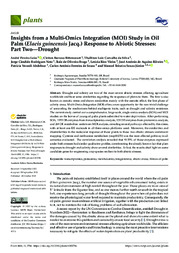Insights from a Multi-Omics Integration (MOI) Study in Oil Palm (Elaeis gineensis Jacq.) Response to Abiotic Stresses: Part Two - Drought.
Insights from a Multi-Omics Integration (MOI) Study in Oil Palm (Elaeis gineensis Jacq.) Response to Abiotic Stresses: Part Two - Drought.
Author(s): LEAO, A. P.; BITTENCOURT, C. B.; SILVA, T. L. C. da; RODRIGUES NETO, J. C.; BRAGA, I. de O.; VIEIRA, L. R.; RIBEIRO, J. A. de A.; SOUSA, C. A. F. de; ABDELNUR, P. V.; SOUZA JUNIOR, M. T.
Summary: Drought and salinity are two of the most severe abiotic stresses affecting agriculture worldwide and bear some similarities regarding the responses of plants to them. The first is also known as osmotic stress and shows similarities mainly with the osmotic effect, the first phase of salinity stress. Multi-Omics Integration (MOI) offers a new opportunity for the non-trivial challenge of unraveling the mechanisms behind multigenic traits, such as drought and salinity resistance. The current study carried out a comprehensive, large-scale, single-omics analysis (SOA) and MOI studies on the leaves of young oil palm plants submitted to water deprivation. After performing SOA, 1955 DE enzymes from transcriptomics analysis, 131 DE enzymes from proteomics analysis, and 269 DE metabolites underwent MOI analysis, revealing several pathways affected by this stress, with at least one DE molecule in all three omics platforms used. Moreover, the similarities and dissimilarities in the molecular response of those plants to those two abiotic stresses underwent mapping. Cysteine and methionine metabolism (map00270) was the most affected pathway in all scenarios evaluated. The correlation analysis revealed that 91.55% of those enzymes expressed under both stresses had similar qualitative profiles, corroborating the already known fact that plant responses to drought and salinity show several similarities. At last, the results shed light on some candidate genes for engineering crop species resilient to both abiotic stresses.
Publication year: 2022
Types of publication: Journal article
Unit: Embrapa Agroenergy
Keywords: Abiotic stress, African oil palm, Integratomics, Metabolomics, Proteomics, Transcriptomics
Observation
Some of Embrapa's publications are published as ePub files. To read them, use or download one of the following free software options to your computer or mobile device. Android: Google Play Books; IOS: iBooks; Windows and Linux: Calibre.
Access other publications
Access the Agricultural Research Database (BDPA) to consult Embrapa's full library collection and records.
Visit Embrapa Bookstore to purchase books and other publications sold by Embrapa.

